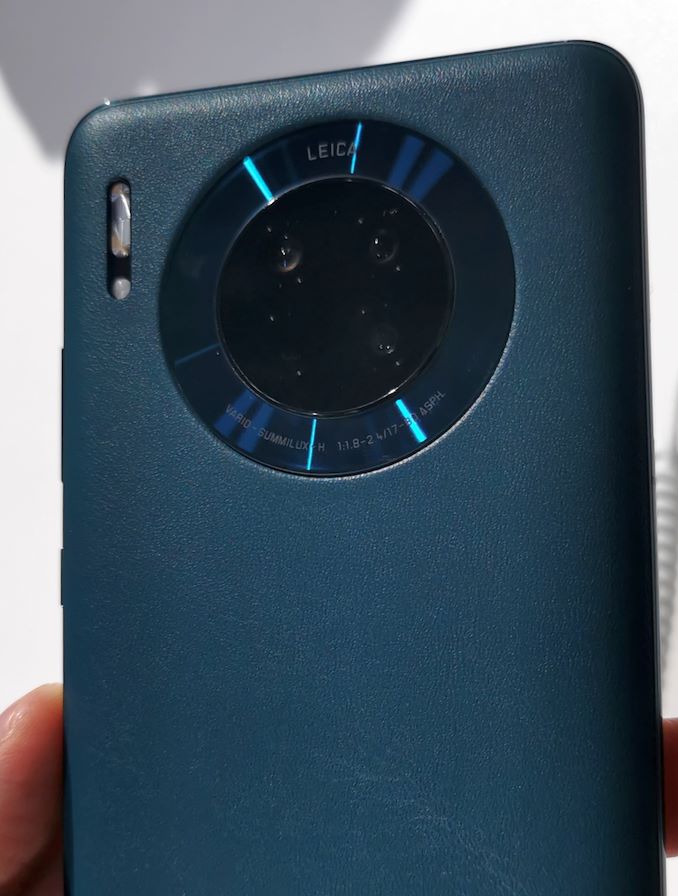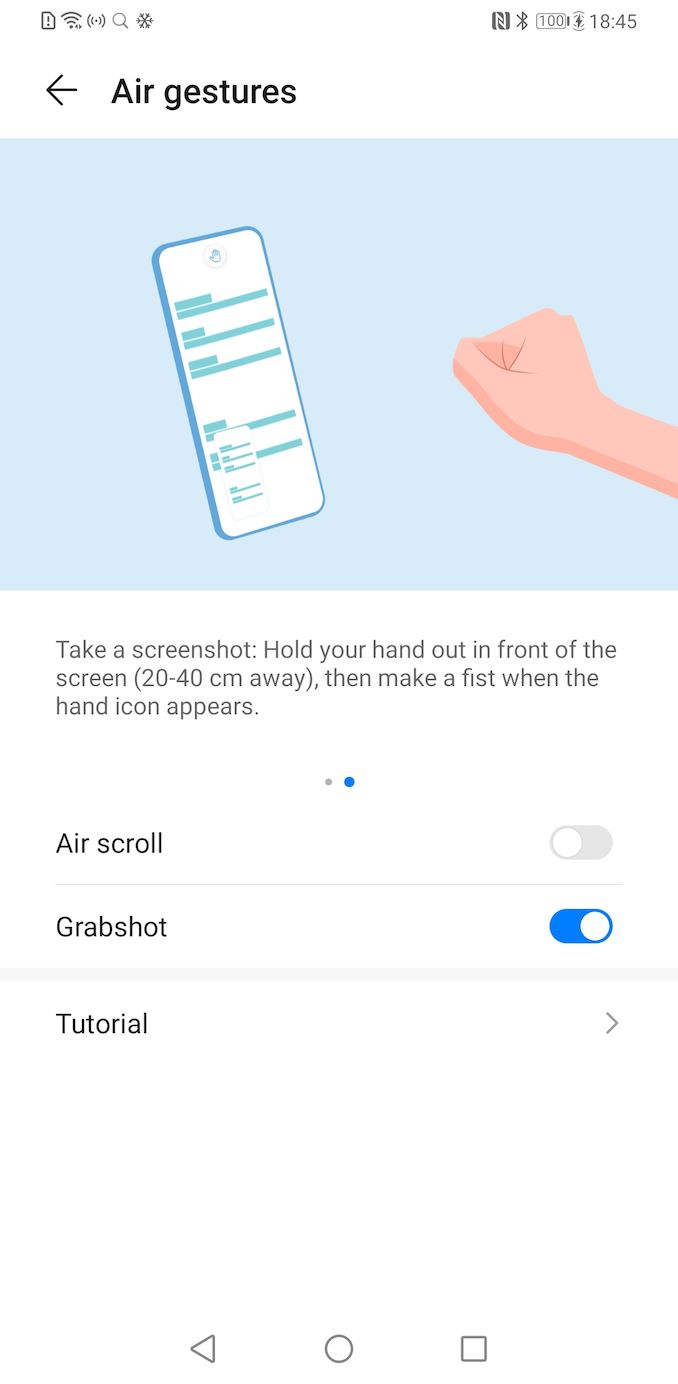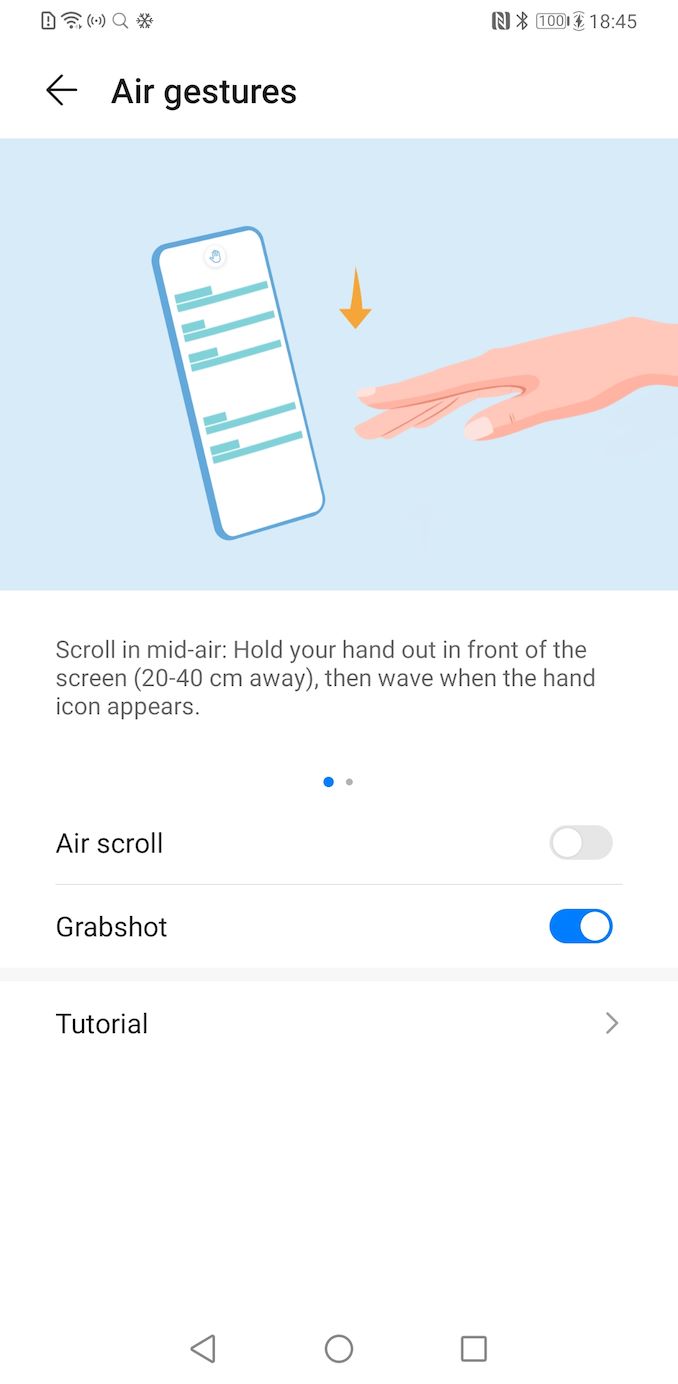A Day with the Huawei Mate 30 Pro: Kirin 990 and 7680 FPS Slow Motion Tests
by Dr. Ian Cutress on September 23, 2019 4:00 AM EST- Posted in
- Smartphones
- Huawei
- Kirin 990
- Mate 30 Pro
- 7680fps
The Technical Details
Inside the device beats the heart of Huawei’s latest silicon design efforts: a HiSilicon Kirin 990 SoC. We’ve covered the SoC in some detail already – we have an eight core design built on TSMC’s 7nm that uses Arm Cortex A76 cores and an Arm Mali G76MP16 GPU. Compared to the previous Kirin 980, these cores have had slight increases, but nothing to write home about. The biggest change is in the NPU for AI processing, where Huawei has changed from its licensed Cambricon design to its own in-house Da Vinci architecture, allowing for full AI network support. Huawei has added in a ‘tiny’ Da Vinci NPU to run super-low-power networks such as voice recognition, and a high-powered ‘large’ Da Vinci NPU for performance related AI such as image detection and enhancement. The CPU, GPU, and NPU, also get an additional layer of cache to help with its speed up.
| Huawei Mate 30 Series | ||||
| AnandTech | Mate 30 | Mate 30 Pro (Mate 30 Pro 5G) |
||
| SoC | HiSilicon Kirin 990 2x Cortex-A76 @ 2.86 GHz 2x Cortex-A76 @ 2.09 GHz 4x Cortex-A55 @ 1.86 GHz |
|||
| (HiSilicon Kirin 990 5G) 2x Cortex-A76 @ 2.86 GHz 2x Cortex-A76 @ 2.36 GHz 4x Cortex-A55 @ 1.95 GHz |
||||
| GPU | Mali G76MP16 @ 600MHz (Mali G76MP16 @ 700MHz) |
|||
| DRAM | 8GB LPDDR4X | 8GB LPDDR4X | ||
| Display | 6.62" OLED 2340 x 1080 (19.5:9) |
6.53" OLED 2400 x 1176 (18.4:9) edge-to-edge |
||
| Size | Height | 160.8 mm | 158.1 mm | |
| Width | 76.1 mm | 73.1 mm | ||
| Depth | 8.4 mm (9.2mm) |
8.8 mm (9.5mm) |
||
| Weight | 196 grams | 198 grams | ||
| Battery Capacity | 4100mAh (Rated) 4200mAh (Typical) 40W charging |
4400mAh (Rated) 4500mAh (Typical) 40W charging |
||
| Wireless Charging | 27W charging + reverse charging | |||
| Rear Cameras | ||||
| Main | 40MP f/1.8 RYYB sensor 27mm equiv. FL |
40MP f/1.6 OIS RYYB sensor 27mm equivl. FL |
||
| Telephoto | 8MP f/2.4 OIS 3x Optical zoom 80mm equiv. FL |
|||
| Wide | 16MP f/2.2 Ulta wide angle 17mm equivl. FL |
40MP f/1.8 RGGB sensor Ultra wide angle 18mm equivl. FL 720p7680fps video capture |
||
| Extra | - | 3D Depth Camera | ||
| Front Camera | 24MP f/2.0 | 32MP f/2.0 | ||
| Storage | 128 / 256GB + proprietary "nanoSD" card |
|||
| I/O | USB-C 3.5mm headphone jack |
USB-C | ||
| Wireless (local) | 802.11ac (Wifi 5), Bluetooth 5.1 |
|||
| Cellular | 4G LTE (4G + 5G NR NSA+SA Sub-6GHz) |
|||
| Splash, Water, Dust Resistance | IP53 (no water resistance) |
IP68 (water resistant up to 1m) |
||
| Dual-SIM | 2x nano-SIM | |||
| Launch OS | Android 10 w/ EMUI 10 without Google services |
|||
| Launch Price | 8+128 GB: 799€ |
8+256 GB: 1099€ (5G 8+256GB: 1199€) |
||
Huawei does have a faster Kirin 990 version on the way, the Kirin 990 5G: this chip is built using 7nm+ EUV, doubles the size of the NPU, but most importantly includes a 5G sub-6 GHz modem on board. This chip will be used in the Mate 30 5G and Mate 30 Pro 5G versions, which are coming out in China this year and select worldwide markets over time. We’re hoping to get hold of the 5G version to see for any quality differences between the 7nm and 7nm+ processes.
The display is a 6.53-inch 2400x1176 Flex OLED display, which comes in at that odd aspect ratio of 18.4:9. This is because of that wrap-around ‘horizon’ display, that comes over the edges. As mentioned on the previous page, some applications ignore these extra sides and act as if the display is a more standard 19:9 to 20:9 display. Huawei states that the display supports the DCI-P3 color space, though does not disclose how much of the gamut it covers, nor the brightness levels of the screen or the accuracy therein.
For the cameras, as mentioned on the previous page, Huawei is positioning the Mate 30 Pro as a premium professional photography assistant device to go alongside more expensive hardware. The three main sensors include a main 40MP f/1.6 OIS RYYB (27mm) sensor, a wide-angle 40MP f/1.8 RGB (18mm) sensor with support up to 7680 fps at 720p, and a final telephoto 8MP f/2.4 OIS with 3x optical zoom. Also included on the rear is a 3D depth camera.
The front camera is a 32MP f/2.0 selfie camera, paired with a proximity sensor, two 3D depth cameras, and a gesture sensor. The two gestures supported include taking a screenshot by making a fist, or scrolling up and down by waving.
The fingerprint sensor is embedded in the display, with Huawei stating that they’re using the latest generation technology. Based on previous Huawei devices, we assume this is a Goodix in-screen fingerprint sensor, which was confirmed via Goodix’s twitter feed. However, when quizzed as to which generation sensor (we know Goodix has at least four), neither Huawei nor Goodix responded to our inquiry.
The battery for the Mate 30 Pro comes in at 4500 mAh, although the company didn’t go into too many details about how long this should last. Huawei is offering the Mate 30 Pro in one main configuration: 8 GB of LPDDR4X-3733 for DRAM, and 256 GB for storage. The device is dual nano-SIM, supporting dual connections, and one of the slots supports Huawei’s proprietary nanoSD card. For the 5G model, both SIM slots can be 5G enabled, although only one at a time. Wi-Fi support is listed as Wi-Fi 5.













47 Comments
View All Comments
Ian Cutress - Tuesday, September 24, 2019 - link
Did you fail to read the very last line of this hands on?s.yu - Tuesday, September 24, 2019 - link
If you're suggesting that the full review will be Andrei's, that's not my point, my point is that whoever, at Anandtech, tested the device in this limited scope, should have done better. The title is called "Kirin 990 and 7680 FPS Slow Motion Tests" after all, there's no point in releasing these non-indicative results if Andrei's going to do it all over again, properly.philehidiot - Thursday, September 26, 2019 - link
You're picking and choosing what to criticise, aren't you? The title starts with "A day with".A DAY.
If you're going to quickly go over most aspects of a device in a day, you have to use what's around. If you can fully set up tests and review a slow motion camera in a day, along with all the other stuff here, set up your own site and compete. You're being unrealistic and hypercritical whilst also being wilfully dishonest to achieve your ends.
When you're done being all upset that you're getting this kind of response from people, do consider if this keeps happening the problem isn't everyone else.
s.yu - Thursday, September 26, 2019 - link
lol, Here's a fool looking for humiliation.You're talking about taking "a day" literally? As in he's had this device for exactly 24hrs? Then obviously you need to take the rest of the title literally don't you, "Kirin 990 and 7680 FPS Slow Motion Tests"
And what do we have regarding the conclusion of an article under this title? "The big question on everyone’s lips is whether Huawei can survive without the Play Store, and then in turn, without Google’s main apps like Gmail, YouTube, or Maps." In fact half of the whole conclusion is regarding "whether Huawei can survive without the Play Store" blah blah blah. What's that got to do with "Kirin 990 and 7680 FPS Slow Motion Tests"? Nothing! It means that the title cannot be taken literally! Your sophistry hinges on the assumption that the first half of the title means what it says, yet the conclusion already proves the second part false, it means you need a half-true-half-false title in which the true part is what you want it to be, I think that's called "being unrealistic and hypercritical whilst also being wilfully dishonest to achieve your ends", lol.
s.yu - Thursday, September 26, 2019 - link
Also, my fundamental point stands that he's condoning Huawei's lies by calling it clever, which is an extension from his last article in which he took on the tone of Huawei's mouthpiece, and it also stands, no matter how much time he actually had or could have had with the device, that the results are non-indicative aside from proving Huawei's 1-to-4 frame interpolation, in addition to the fact that Andrei's doing the full review sometime later, that, according to you, must include a proper, indicative test of the slo-mo anyway since he's not on a deadline or on a very loose one per usual Anandtech, it's a futile exercise, and so, what should I call this article then...yes, Huawei clickbait.philehidiot - Saturday, September 28, 2019 - link
"Fool"? I call myself an idiot in my name. Don't you DARE try to imply I'm anything less than an idiot. Prat. Also, if you're going to insult someone's intelligence, please consider capitalisation, etc. Glass house, stones, etc. Get your own act together before insulting.So half the conclusion is on the most important question surrounding this phone and you're criticising this? And you're insisting on bitching about the title not being completely literal as your main point? So, using a load of electronic trickery to produce massive frame rates is not clever? Okay, YOU do it. If it's not clever, it's clearly within the reach of the average which should be well within your grasp as you're calling other people fools. So you must think you're clever.
I'm sensing some Dunning-Kruger going on here.
So, if the whole thing is a futile exercise, please do tell.... why are you bothering reading it all and excreting your opinion all over the rest of us? Do tell. I'm sure your time is far better spent doing all these amazing things you should be doing rather than attempting to shit all over everyone else's work.
Huawei clickbait? I'd say Anandtech would be more predisposed towards Qualcomm clickbait given they take money and so on from them.
And yes, the results prove that the interpolation works.... as well as a couple of ways it's difficult to use and some settings it works well in and some it doesn't. Y'know... the overview implied by the bloody title. Why do reviews sites look at motherboards and bench them when the results are usually within a few percent of a competing board? Or why do they test two SSDs of two differing brands which use identical controllers and NAND? Because companies lie, cheat and steal and checking the stuff does what it claims to do is the first step towards informing the consumer.
Now, please do consider your arrogance and attitude is not helping your case. You could make a good one people will read. But... you chose to go down the "insult everyone else until they agree with me" route. No one will EVER agree with you or take you seriously if you feel you have to insult them to get your point across.
Twat. ;)
s.yu - Sunday, September 29, 2019 - link
I commend you for your self-awareness of your idiocy.There's not much worth arguing about considering hardly anything stands in your idiotic rant.
"on the most important question surrounding this phone"
Says you, many on the site agree that it's political BS. Go back to the Richard interview and count how many people agree with me.
"And you're insisting on bitching about the title not being completely literal as your main point? "
Rather that's your main point, how "A DAY", in all caps, excuses the sloppy job. I won't waste my time reiliterating my main point what I've stressed in abundance.
"a load of electronic trickery to produce massive frame rates"
No, it's deceitful. 1920fps readout interpolated x4 != 7680fps readout, far from equal. I don't even dare do 4x interpolations on Twixtor because of how poorly the results turn out, and this is at an even lower processing precision on a low power platform real-time. I don't do it because I have a bottom line, not Huawei. As far as I‘m aware all slo-mo have been advertised as their actual readout speed until Huawei came along and turned a native 480fps device into "960fps" through a firmware update just because Sony could do real 960fps. You're free to prove me wrong with an earlier example though.
"I'm sensing some Dunning-Kruger going on here."
Sense harder, and you'll sense where it actually happens.
"if the whole thing is a futile exercise"
This whole article is a futile exercise, given that there will be a more comprehensive one by Andrei which, again, according to you does not make the sloppy mistakes in this one because of a loose timeline. However there's no way for me to know until I've read it through, is there. You really are such an idiot that you ask 7N oxygen-free idiotic questions.
"Anandtech would be more predisposed towards Qualcomm clickbait "
Sorry but the Qualcomm articles adhere to Anandtech's quality standard and are strongly critical in many instances, OTOH Ian in this article (and the Richard one) takes on an inappropriately welcoming tone towards blatant dishonesty and corporate jargon. And FYI he got free trips to China from Huawei, possibly other freebies.
"as well as a couple of ways it's difficult to use and some settings it works well in and some it doesn't"
Not nearly as clear as it should be, Youtubers could do better than this.
"Why do reviews sites look at motherboards and bench them when the results are usually within a few percent of a competing board..."
You're inadvertantly agreeing with me, idiot.
"Now, please do consider your arrogance and attitude is not helping your case."
Though you did a good job about your idiocy back there, there's still call for some self-refection.
"No one will EVER agree with you or take you seriously if you feel you have to insult them to get your point across."
Look again where the insult started, and with some Dunning-Kruger, ironically.
"Twat. ;)"
I'll take that as your motto.
pinchies - Friday, September 27, 2019 - link
Dear Ian,Those sample videos clearly show that they are using optical flow image processing to interpolate frames. Even though this is a quick look article, I think that extended slow-mo section should be edited to add a clarification that this is not native 7680fps, which is simply clickbait being peddled by Huawei. There are apps on the mobile stores that can do this kind of interpolation, we only care about the hardware refresh rate.
s.yu - Friday, September 27, 2019 - link
Spot on.Haldi - Wednesday, October 9, 2019 - link
QFT!